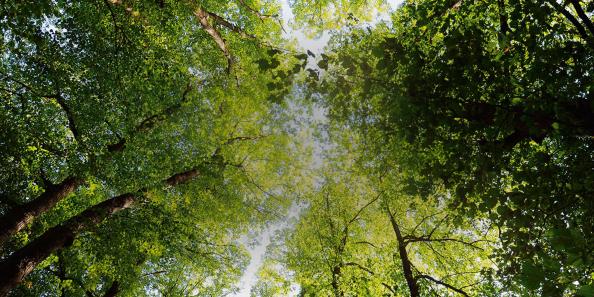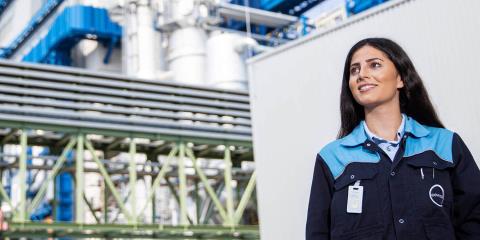
Sustainability as a compass
Covestro is advancing sustainability at all levels, driven by the “People, Planet, Profit” principle – the backbone of the company. It reflects the company's dedication to creating economic, ecological, and social value through its business activities. Covestro is also guided by the Sustainable Development Goals of the United Nations. They are an integral part of the corporate strategy.
By developing pioneering technologies and products, the company significantly contributes to improving the livelihoods and quality of life of millions of people worldwide. The German sites play an important role in these plans.
Operational climate neutrality by 2035
Covestro has set itself ambitious targets: The company aims to be operationally climate neutral by 2035 – thus reducing its emissions from its own production (Scope 1) and from purchased energy sources (Scope 2) to net zero. Three strategic levers are to significantly contribute to achieving these climate targets: the sustainable optimization of its own production processes, the continuous transition of production to electricity from renewable sources, and the increased use of green steam.
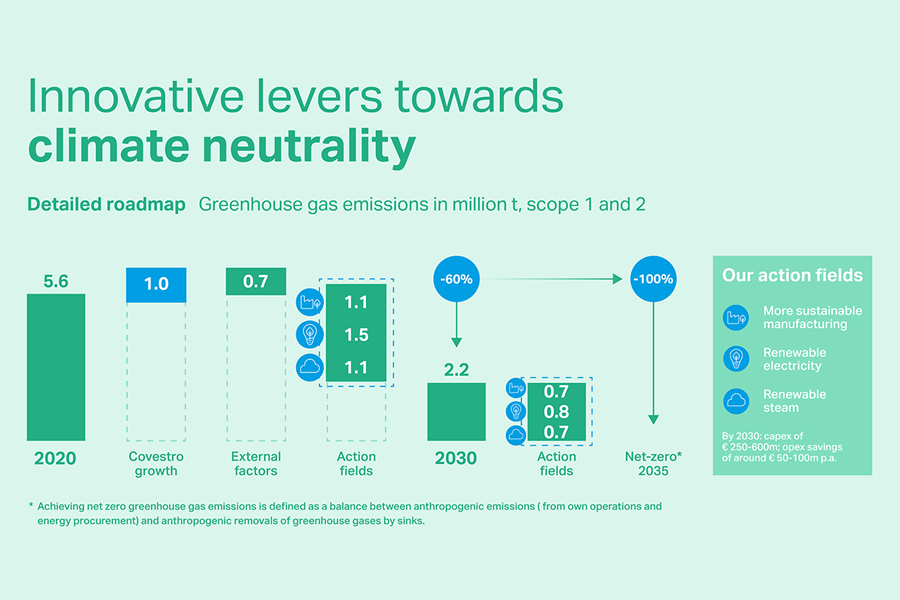
Targets have been set for Scope 3
Covestro is also targeting all other greenhouse gas emissions that occur upstream and downstream in the value chain (Scope 3). These account for around 80 percent of the company's total greenhouse gas emissions and are to be reduced by ten million tons of CO₂ by 2035 in the short term. This corresponds to a 30 percent reduction in emissions compared to the base year 2021, whereby growth-related emissions up to 2035 are already partially included here.
Covestro aims to become climate-neutral for Scope 3 emissions by 2050 at the latest. One thing is clear: reducing Scope 3 emissions requires a change in the entire value chain. Various factors that influence each other – including the availability of alternative raw materials, renewable energies, technological advances, new processes and the transformation of customer markets – play a decisive role in this.
Circular economy as a guiding principle
Since 2019, Covestro has been fully aligned to the circular economy with a comprehensive program to achieve its sustainability goals. To this end, the company also heavily relies on cooperations – throughout the entire value chain and, in particular, in the interaction between different sectors. The aim of the circular economy is to use products as long as possible and several times as well as to avoid waste and to use end-of-life products such as used plastics as a valuable resource. Covestro is developing innovative recycling technologies for this purpose.
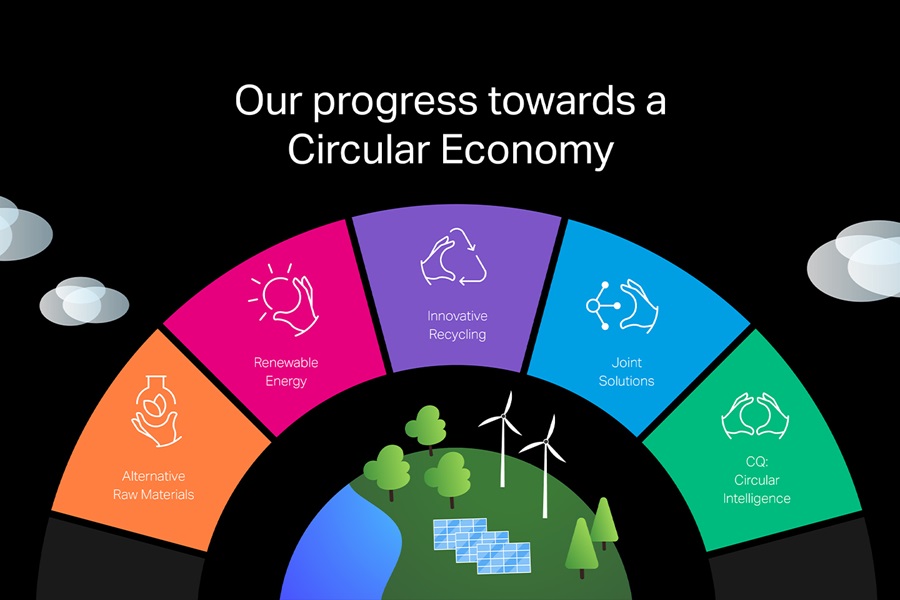
In addition, the company uses alternative raw materials such as biomass, used materials and waste in its production, thereby reducing dependence on fossil resources such as oil as much as possible. With its detailed circular economy program, which also includes the use of renewable energies, the materials manufacturer wants to help protect the climate, conserve limited natural resources, and set an example for the entire plastics industry.
Circular economy as a guiding principle
Covestro has been advancing the use of alternative raw materials ever since its inception. In doing so, the company is breaking completely new ground – both in terms of product development as well as process optimization. Thanks to alternative raw materials, petroleum consumption at the sites can be significantly reduced. This not only benefits the climate, but also the environment. This is one of the reasons why Covestro intends to further accelerate the use of alternative raw materials and launch new processes on the market.
The demand for sustainable products continues to grow. Covestro has responded to this development at an early stage. In the future, the company aims to offer every product in a climate-neutral version.
Already today, the portfolio of sustainable material solutions is growing continuously. At its site in Krefeld-Uerdingen, Covestro produces the world's first climate-neutral2 polycarbonate. The basis for the product is provided by raw materials from mass-balanced biowaste and residual materials as well as renewable energy. The advantage: customers can use it immediately in their production without any changeover and without compromising on quality.
This also applies to the climate-neutral2 methylene diphenyl diisocyanate (MDI) from Krefeld-Uerdingen. The raw material is in high demand worldwide. It is used in the production of rigid polyurethane foam – a very effective insulating material for buildings. That is not surprising: the use of polyurethane insulation can reduce heating or cooling requirements by up to 70 percent.

The materials manufacturer also wants to offer every product in a climate-neutral version going forward: the world's first climate-neutral¹ polycarbonate comes from Krefeld-Uerdingen. And under its CQ (Circular Intelligence) label, Covestro offers a portfolio of products that consist of at least 25 percent alternative, non-fossil raw materials.
2Climate neutrality is the result of an internal assessment of a partial product life cycle from raw material extraction (cradle) to the factory gate (of Covestro), also known as cradle-to-gate assessment. The methodology of our LCA, for which an external audit and certification will soon be available, is based on the ISO 14040 and 14044 standards. The calculation takes into account biogenic carbon sequestration based on preliminary data from the supply chain. No compensation measures were applied.
Excellent market opportunities are anticipated for bio-based raw materials. They make production even more sustainable. Covestro is one of the pioneers in the chemical industry in their use. Among other things, the company has succeeded in producing aniline from biomass at its site in Leverkusen.
Aniline has numerous functions in production. The chemical is used, for example, as a basis for the production of medicines, dyes and plastics. Covestro requires aniline primarily for the production of methylene diphenyl diisocyanate (MDI), a main component of foam insulation. Until now, aniline has been obtained from benzene, which in turn comes from crude oil.

However, Covestro has managed to achieve an important breakthrough. In the synthesis of aniline, the company has for the first time developed a process in which corn or straw, for example, can be used to produce the chemical. Thus, bio-based aniline can be made of one hundred percent renewable carbon. This represents an opportunity to significantly reduce the use of fossil raw materials in the company's own plants in the future.
For this purpose, the plastics manufacturer put a special pilot plant into operation at the beginning of 2024. Larger quantities of bio-based aniline are produced at this plant for the first time with the aim of further developing the new technology for production and transferring it to an industrial scale.

Covestro has received ISCC Plus certification for its sites in Leverkusen, Dormagen, Krefeld-Uerdingen (ISCC: International Sustainability and Carbon Certification). The mass balance approach relies on the use of certified recycled and biobased raw materials from the start of production and thus promotes the development of a circular economy. It enables fossil raw materials to be saved along the entire value chain and greenhouse gas emissions to be reduced.
Various mass-balanced products are manufactured at the three NRW sites. These include selected polycarbonates, components for polyurethane (PU) rigid and flexible foams, PU coating and adhesive raw materials, thermoplastic polyurethanes (TPUs) and specialty films. They are characterized by equally good quality and properties as products made from fossil raw materials. With ISCC Plus certification, Covestro is driving the circular economy further forward. Covestro aims to become operationally climate-neutral by 2035 – and thus further significantly reduce emissions from its own production (Scope 1) and from purchased energy sources (Scope 2). By 2050, emissions from upstream and downstream processes in the value chain (Scope 3) are also to be reduced to net zero.
Sustainable coatings are expected to further reduce the CO₂ footprint of cars in the future. This is the goal of a project team in which employees from Covestro, BASF, and Audi are working together. They teamed up to coat test bodies of an Audi Q2 with a clearcoat containing a partially bio-based hardener – under near-production conditions.
Around 70 percent of the plastic content of the hardener comes from biomass. This makes it possible to significantly reduce the use of raw materials in production processes. The initial test results have shown that the vehicle coating meets the specific requirements of the car manufacturer even with the innovative clearcoat. While not all tests have been completed to the point of series production release, the project partners feel the result is an important step on the road to even more sustainable automotive coatings.
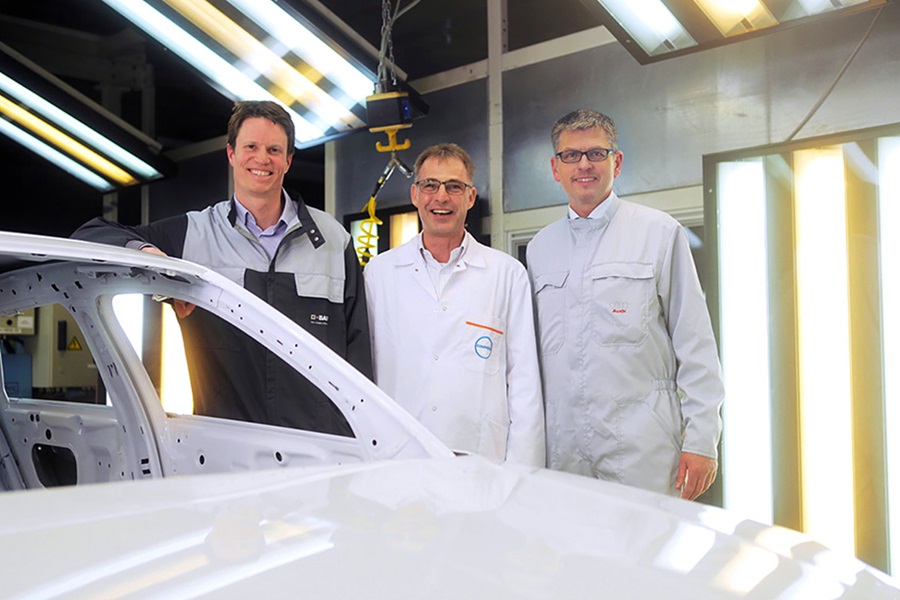
Recycling
Plastic products are thrown away way too often at the end of their life. This needs to change. They should be viewed as a valuable resource. The guiding principle should be to use products as long as possible. Covestro promotes innovative recycling technologies to keep plastic waste inside the value cycle. The company has set up more than 20 research and development projects. At the same time, Covestro is pushing the boundaries of what is possible to conserve valuable resources.
Mattresses contain 15 to 20 kilograms of foam on average. As trailblazer for industrial recycling, Covestro is trying to figure out new ways how to reuse the valuable resources at the end of their product life. That is why the company has recently started operating a pilot plant for the chemical recycling of flexible polyurethane (PU) foam from used mattresses in Leverkusen.
For the first time, the two main PU-components polyol and an isocyanate precursor can be recycled. The process builds on the company’s involvement in the "PUReSmart" research project. The aim of the pilot plant is to verify the positive laboratory results achieved to date. By using the innovative process, Covestro can close material loops, replace fossil resources in production, and offer new solutions for dealing with plastic waste. At the same time, the company succeed in proving that polyurethanes are recyclable.
As part of the "PUReSmart" research project, Covestro also worked with the two companies Recticel and Redwave to develop an intelligent sorting solution to efficiently separate the different PU foams from post-consumer mattresses. The software uses machine-learning algorithms for a proper recognition of the different types of foam, enabling clean material inputs for the subsequent recycling process. This is an important step in advancing the circular economy.
Covestro has developed an innovative process for the chemical recycling of polycarbonate – and thus achieved another important milestone toward a circular economy. In this approach, plastics are reverted to a precursor stage, allowing them to be reintroduced as alternative raw materials into the production process. The return of plastics through recycling replaces primary fossil raw materials in production.
The technical implementation of chemical recycling is now beginning on a pilot scale at the Leverkusen site. Millions of euros will be invested in this project over the next few years. On the way to industrial scale, the process is still being optimized and is undergoing further development stages. This approach protects valuable resources and thus the environment.
The newly developed process is a specific chemolysis process adapted to polycarbonate. Pre-sorted waste streams containing a product content of more than 50 percent polycarbonate can be recycled this way. The recyclate can be mass-balanced and reused as a raw material for the production of polycarbonate without further processing.

The construction industry is the second largest plastics application sector in Germany. The “KUBA” pilot project, which is funded by the German Federal Ministry of Education and Research, is therefore investigating how the industrial sector can increasingly use plastics in cycles in the future – also with the aim of recovering raw materials for new products.
Admittedly, a number of collection and recycling systems already exist. However, common processes such as the mechanical recycling of plastic waste currently often encounter technical and economic limits. That’s why feedstock recycling could be a solution. In this process, plastic waste is broken down into basic chemical substances and then reused as a raw material.
“KUBA” has been coordinated by DECHEMA Gesellschaft für Chemische Technik und Biotechnologie e. V. since December 2018. Covestro is one of eleven industrial companies that are partners in the pilot project.
The consortium's final report highlighted the necessity for further research beyond the investigation's findings. This encompasses optimizing the interface between mechanical processing and chemical recycling. The objective is to maximize both product yield and product quality. This includes the expansion to other types of plastic waste, such as polyurethane-based insulating materials. Such advancements are necessary to enable the value chain on the largest scale and thus achieve ambitious recycling rates and low greenhouse gas emissions for construction plastics.

Energy efficiency and power supply
The chemical industry is one of the most energy-intensive industries in the world. Covestro therefore relies on a reliable supply of electricity at internationally competitive prices. At the same time, the company takes its responsibility seriously and is continuously working to further minimize the energy consumption of its sites.
For Covestro, energy efficiency is not just a competitive factor, but an essential lever for achieving operational climate neutrality. In March 2025, Covestro therefore announced an ambitious energy efficiency target for global production: By 2030, the company aims to use 20 percent less energy to manufacture one metric ton of product than in 2020. This corresponds to around 550,000 metric tons less CO2 emissions annually – roughly the same as the annual CO2 emissions of a city with a population of around 70,000.
To achieve this goal, Covestro plans to reduce the specific primary energy demand at its three North Rhine-Westphalia sites alone by a further 25 percent by 2035 compared to 2020 through targeted energy management. The company aims to save around 1,100 gigawatts of primary energy per year from 2035. Covestro has already implemented numerous measures in Germany that help make production more climate and environmentally friendly.
With its TDI plant in Dormagen, Covestro is setting new standards in energy efficiency. The largest plant of its kind in Europe has been in operation since 2014 and was modernized from summer 2023 to March 2025. Thanks to innovative technology, it requires up to 80 percent less energy than conventional processes. This saves around 22,000 metric tons of CO₂ annually.
The centerpiece of the modernization is a new reactor that weighs over 150 metric tons and is almost 20 meters high. This makes it possible to use the reaction energy generated by the TDI plant to generate steam. This investment supports Covestro's ambitious energy efficiency target of reducing energy consumption per metric ton of product by 20 percent by 2030 compared to 2020 and achieving operationally climate-neutral production by 2035. At the same time, the company is strengthening its competitiveness in the face of high energy costs in Europe. The implementation was partially funded by the German Federal Ministry for Economic Affairs and Climate Protection.

Covestro is driving the shift towards climate neutrality: From 2025, rail tank car transports on the German rail network will be powered by renewable energies and sustainable biodiesel. This changeover will reduce CO₂ emissions by around 3,000 metric tons per year and support the company's climate targets.
In cooperation with the transport and logistics company DB Cargo AG, all transports on the mostly electrified lines are powered by electricity from renewable sources. For non-electrified sections, HVO 100 is used – a sustainable biodiesel produced from plant and animal oils, fats and residues. The logistics partners Chemion and the Hoyer Group, which handle transportation between the Chemparks and the Deutsche Bahn (DB) network, also rely on HVO. This makes transportation completely sustainable from production to customer. Covestro's goal is to convert all rail transportation in Europe to renewable energies as well.
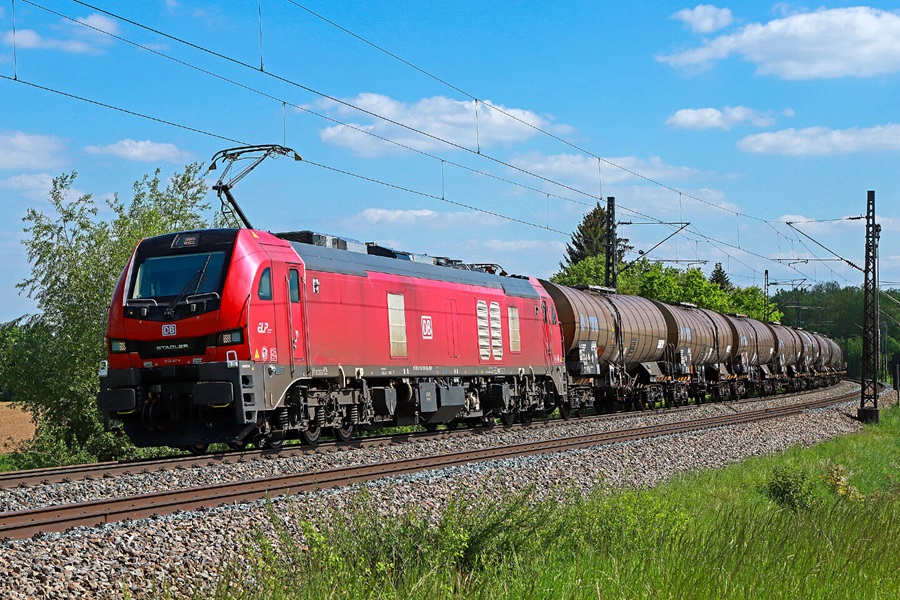
Covestro aims for climate neutrality by 2035. The long-term goal is to rely on 100 percent energy from renewable sources. To this end, the company has already made some landmark decisions.
In 2019, Covestro signed the world's largest industrial corporate supply agreement (Corporate Power Purchase Agreement, PPA) for electricity from offshore wind turbines to date with Ørsted. Starting in 2025, the Danish energy supplier will provide green electricity from the newly created offshore wind farm off the island of Borkum for ten years. The agreement covers 100 megawatts of capacity and thus covers a significant amount of Covestro Germany's electricity needs.

In addition, Covestro also focuses on using solar power. The materials manufacturer agreed on long-term PPA with the German energy company EnBW. Since 2022, Covestro has purchased 63 megawatts of power from EnBW's "Weesow-Willmersdorf" solar park in Brandenburg. The contract is initially set to run for 15 years. Covestro plans to use the solar power at its Dormagen and Krefeld-Uerdingen sites primarily for the production of sustainable, mass-balanced plastics manufactured using the drop-in process. The agreement with Covestro is the project's first industrial customer supply contract.

By switching to renewable energies, Covestro is not only a step closer to meeting its own climate targets. Wind and solar power increase the sustainability of Covestro's own production processes and at the same time help customers to reduce their own carbon footprint. In 2023, Covestro in Germany already obtained 17 percent of its energy from renewable sources.
It is impossible to imagine the chemical industry without chlorine. Around two-thirds of all products are based on this important raw material – for example polymers, pharmaceuticals, and chemicals for drinking water treatment. Chlorine production is one of the most energy-intensive processes of all and therefore a real cost factor.
However, Covestro has now pushed the boundaries of what is possible in this area yet again. Together with partners from industry, the company has developed a technology that can reduce the amount of energy required for chlorine production by 25 percent. The innovative oxygen depolarized cathode (ODC) is already in use in Germany at the Krefeld-Uerdingen site at partial capacity.
The new process is fundamentally based on the common membrane process of chloralkali electrolysis, in which chlorine, caustic soda, and hydrogen are extracted from table salt (NaCl) and water. However, there is one subtle but crucial difference: the hydrogen-generating electrode that is usually used is replaced by an oxygen depolarized cathode. The supply of oxygen to the cathode subsequently prevents the formation of hydrogen. This way, only chlorine and caustic soda can be obtained.
The German Federal Ministry of Education and Research (Bundesministerium für Bildung und Forschung – BMBF) funded the project as part of the “Research for Sustainability” (FONA) initiative. The technology was awarded the 2019 Covestro Science Medal for outstanding innovative and sustainable performance.
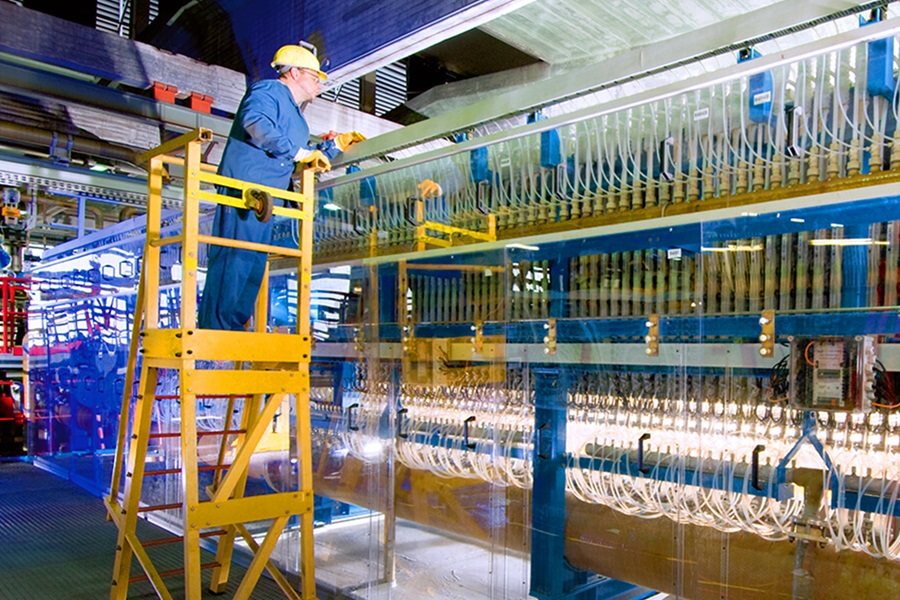
Covestro is one of the world’s leading producers of methylene diphenyl diisocyanate (MDI). The raw material is used, among other things, for the production of energy-efficient insulation solutions for buildings and refrigeration equipment. According to forecasts, the global market for MDI is expected to undergo further growth. Thanks to adiabatic isothermal phosgenation (AdiP) technology, Covestro is well prepared for the expected increase in demand.
The company has spent around 20 years refining the innovative AdiP technology. The result is impressive: Production output has increased by 50 percent compared to the technology currently in use. At the same time, the technology stands out for its high environmental friendliness. It enables a significant reduction in energy requirements and CO₂ emissions. The key is an optimized reaction design that allows Covestro to dispense with external energy input. This is also where the name of the technology comes from. This is because the reaction is adiabatic-isothermal.
The savings potential in an MDI plant with AdiP technology is enormous. It amounts to up to 40 percent less steam and up to 25 percent less electricity per ton of MDI produced. This corresponds to a reduction in energy-related CO₂ emissions of around 35 percent. The technology is thus making an important contribution to Covestro’s sustainability goals.
So far, AdiP has only been used in a pilot project at the Brunsbüttel site. However, once successfully completed, it will be available for implementation in the next world-scale plant.
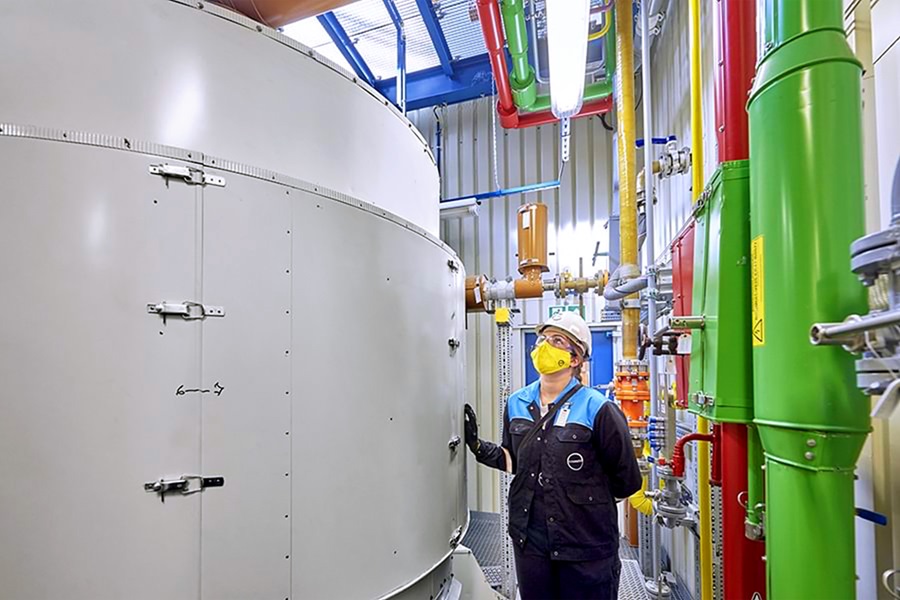
Since the beginning of 2023, a 2.3-kilometre-long steam pipeline has been transporting around 20-bar steam at the Covestro Industrial Park in Brunsbüttel. The new pipeline is part of Covestro's energy efficiency master plan and a further step on the way to climate neutrality. In future, it will save around 8,300 metric tons of CO₂ emissions and 40 gigawatt hours of electricity annually.
The steam line transports the 20-bar steam from the aniline plant to the MDI plant. This reduces the consumption of fresh 34-bar steam, which must first be reduced internally to 20 bar for MDI production. The aniline plant, which produces the 20-bar steam needed in the MDI plant, previously had to reduce the pressure to 5 bar because no corresponding line was available. This led to excess steam in the 5-bar system, which at times remained unused.
Now, with the new 20-bar line, nothing is lost. The steam is used as it is produced in the industrial park. Losses due to pressure reduction no longer exist. Since there is now less surplus steam, the combined heat and power units (CHP) become more efficient and flexible in operation. In addition, electricity consumption is significantly reduced due to the higher utilization of the CHP units, and the reliability of the entire plant increases. This is because the electric quick-start machines are now only used as a backup instead of running continuously.
The 20-bar steam line was realized thanks to a funding commitment from the federal program "Energy Efficiency in the Economy". This enables companies to implement energy efficiency projects that were previously economically unviable. Covestro's innovative project was one of the projects in the competition that achieved the highest savings with the least investment.
The following simple show explains how the 20 bar steam line works:
1Climate neutrality is the result of an internal assessment of a partial product life cycle from raw material extraction (cradle) to the factory gate (of Covestro), also known as cradle-to-gate assessment. The methodology of our LCA, for which an external audit and certification will soon be available, is based on the ISO 14040 and 14044 standards. The calculation takes into account biogenic carbon sequestration based on preliminary data from the supply chain. No compensation measures were applied.








